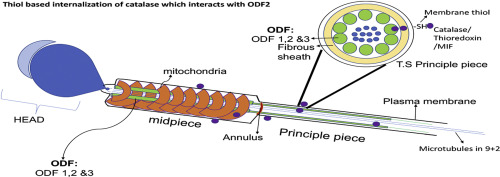当前位置:
X-MOL 学术
›
Free Radical Bio. Med.
›
论文详情
Our official English website, www.x-mol.net, welcomes your
feedback! (Note: you will need to create a separate account there.)
Thiol based mechanism internalises interacting partners to outer dense fibers in sperm.
Free Radical Biology and Medicine ( IF 7.1 ) Pub Date : 2020-01-07 , DOI: 10.1016/j.freeradbiomed.2019.12.031 Kaushiki Kadam 1 , Vrinda V Khole 1 , Kanaka Ghosalkar 1 , Dhanashree Jagtap 2 , Deepthi S Yarramala 3 , Bini Ramachandran 4
Free Radical Biology and Medicine ( IF 7.1 ) Pub Date : 2020-01-07 , DOI: 10.1016/j.freeradbiomed.2019.12.031 Kaushiki Kadam 1 , Vrinda V Khole 1 , Kanaka Ghosalkar 1 , Dhanashree Jagtap 2 , Deepthi S Yarramala 3 , Bini Ramachandran 4
Affiliation

|
The sperm tail outer dense fibres (ODFs) contribute passive structural role in sperm motility. The level of disulphide cross-linking of ODFs and their structural thickness determines flagellar bending curvature and motility. During epididymal maturation, proteins are internalized to modify ODF disulphide cross-linking and enable motility. Sperm thiol status is further altered during capacitation in female tract. This suggests that components in female reproductive tract acting on thiol/disulphides could be capable of modulating the tail stiffness to facilitate modulation of the sperm tail rigidity and waveform en route to fertilization. Understanding the biochemical properties and client proteins of ODFs in reproductive tract fluids will help bridge this gap. Using recombinant ODF2 (aka Testis Specific Antigen of 70 kDa) as bait, we identified client proteins in male and female reproductive fluids. A thiol-based interaction and internalization indicates sperm can harness reproductive tract fluids for proteins that interact with ODFs and likely modulate the tail stiffness en route to fertilization.
中文翻译:

基于硫醇的机制将相互作用的伴侣内化到精子中的外部致密纤维。
精子尾部外部致密纤维(ODF)在精子运动中起被动结构作用。ODF的二硫键交联程度及其结构厚度决定了鞭毛弯曲曲率和运动性。在附睾成熟过程中,蛋白质被内化以修饰ODF二硫键交联并实现运动。精子获能过程中女性精子中的硫醇状态进一步改变。这表明,作用于硫醇/二硫化物的雌性生殖道中的成分可能能够调节尾巴的刚度,从而有助于调节精子的尾巴刚度和受精过程中的波形。了解生殖道液中ODF的生化特性和客户蛋白质将有助于弥合这一差距。使用重组ODF2(又名70 kDa的睾丸特异性抗原)作为诱饵,我们确定了男性和女性生殖液中的客户蛋白质。基于硫醇的相互作用和内在化作用表明精子可以利用生殖道液中的蛋白质与ODF相互作用,并可能在受精过程中调节尾巴的硬度。
更新日期:2020-01-07
中文翻译:

基于硫醇的机制将相互作用的伴侣内化到精子中的外部致密纤维。
精子尾部外部致密纤维(ODF)在精子运动中起被动结构作用。ODF的二硫键交联程度及其结构厚度决定了鞭毛弯曲曲率和运动性。在附睾成熟过程中,蛋白质被内化以修饰ODF二硫键交联并实现运动。精子获能过程中女性精子中的硫醇状态进一步改变。这表明,作用于硫醇/二硫化物的雌性生殖道中的成分可能能够调节尾巴的刚度,从而有助于调节精子的尾巴刚度和受精过程中的波形。了解生殖道液中ODF的生化特性和客户蛋白质将有助于弥合这一差距。使用重组ODF2(又名70 kDa的睾丸特异性抗原)作为诱饵,我们确定了男性和女性生殖液中的客户蛋白质。基于硫醇的相互作用和内在化作用表明精子可以利用生殖道液中的蛋白质与ODF相互作用,并可能在受精过程中调节尾巴的硬度。











































 京公网安备 11010802027423号
京公网安备 11010802027423号